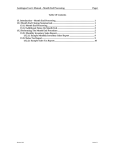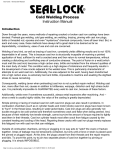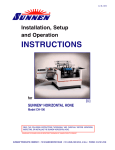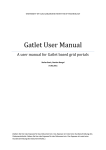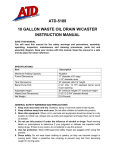Download Turnwrench Car Care User`s Manual
Transcript
Tu r n w r e n c h Car Car e Use r's Ma n u a l Table of Contents Introduction................................................................................................................................................3 Account Information.................................................................................................................................. 3 Shop Location............................................................................................................................................ 3 Switching Locations.............................................................................................................................. 3 Customers...................................................................................................................................................3 Adding a New Customer....................................................................................................................... 3 Finding Existing Customers.................................................................................................................. 4 Customer Categories............................................................................................................................. 4 Vehicles......................................................................................................................................................4 Service Life-Cycle..................................................................................................................................... 4 Quotes....................................................................................................................................................5 Jobs................................................................................................................................................... 5 Parts and Labor................................................................................................................................. 5 Saved Jobs........................................................................................................................................ 5 Repair Orders........................................................................................................................................ 5 Declined Services............................................................................................................................. 6 Invoices................................................................................................................................................. 6 Fees................................................................................................................................................... 6 Payments............................................................................................................................................... 6 Employees.................................................................................................................................................. 6 Employee Roles.....................................................................................................................................6 Time Clock............................................................................................................................................ 6 Inventory.................................................................................................................................................... 7 Suppliers.....................................................................................................................................................7 Supplier Types.......................................................................................................................................7 Reports....................................................................................................................................................... 7 Key Performance Indicators..................................................................................................................7 Marketing................................................................................................................................................... 7 Appointment Scheduling............................................................................................................................7 Introduction Welcome to Turnwrench Car Care! We hope that you will find this tool helpful in your automotive service business. We have designed this software to not only aid your shop in becoming more efficient, but to help you maximize profits and measure your success. At Turnwrench Car Care, we are always looking for feedback and comments. Please feel free to contact us via the contact form on the website. This user's guide will help you understand the features of the Turnwrench Car Care software. It is designed to be sophisticated, yet easy to use. Please see the sections below for more detailed information about specific features. Account Information The most basic information in the system is about your company. You should enter your company name and main contact information on the account page. You will also notice a place to enter disclaimer information that will be used at the bottom of quotes, repair orders, and invoices. There may be multiple shop locations associated with an account, and these are shown at the bottom of the page. Shop Location On the shop location page, you may enter information about each individual location in your business, including address and phone number. Quote numbers and RO/Invoice numbers may be tracked separately and you may start at any number you wish. You will also notice a place to edit sales tax, hazmat, and shop supplies rates. These will automatically be taken into consideration when a quote is created in this location. Key Performance Indicators (KPI) are used to evaluate your shop's performance and will be discussed in a later section. Switching Locations If you have more than one location, you may track each separately. Switching between locations may only be done by and admin user and may be accomplished by clicking on the location name before the “Welcome” greeting. Customers Customers are a vital part of any business. Tracking information about your customers will be vital to not only service, but marketing and retention activities as well. It is highly recommended that you gather the address, phone, and email address from each customer. You may also see the “Payment History” or “RO History” for a particular customer via links on this page. Adding a New Customer You may add a new customer by clicking on “Add a New Customer” under the “Customers” menu. One tool that may be helpful in gathering the necessary information is the “New Customer Form.” This form may be printed and filled out by the individual customer. Finding Existing Customers Once a customer has been added to the system, it will be necessary to refer back to their information often. There are two ways in which to accomplish this. 1) You may view the list under “View All Customers.” 2) You may search for a particular customer using key customer information under “Search for a Customer.” Customer Categories Customers can be categorized into separate groups. Each of these groups may have a separate base labor rate. You can view the categories for your shop location by clicking “View All Categories.” Adding a category may be done by clicking “Add a Category.” Vehicles Each customer may potentially have multiple vehicles. Tracking accurate vehicle data will be vital to such shop processes as producing quotes, ordering specific parts, and sending maintenance reminders. The Customer Forms are useful, printable documents that allow a customer to provide you with pertinent information about the vehicle and its problems. You will find a list of existing vehicles on the customer page. Also, you may search through all vehicles for a location using the “Search Vehicles” page. Service Life-Cycle There are 4 fundamental steps in the Service Life-Cycle 1. Quote Creation – Diagnose and make a bid 2. Repair Order – Order Parts and perform the service 3. Invoice – Service completed; Notify customer 4. Payment – Collect compensation for work done 5. Retention – Continue relationship with customer in order to retain business Quotes Each vehicle may have several quotes associated with it as well as a record of past repair orders and invoices. A quote is the very first step in the Service Life-Cycle. Jobs A quote may consist of multiple jobs. Each job should be a distinct set of of service performed. Parts and Labor Each job will consist of the parts and labor that are required to perform that job. Pricing of parts is based on a proprietary algorithm that takes into consideration the type of supplier and the cost of the part. Labor pricing is also computed according to an algorithm that is based on the shop's labor rate and the number of labor hours. Each of these algorithms is based on industry standards of pricing and is designed to maximize margins and profits for your shop. If some labor was performed by more than 1 technician, the labor can be split between them using the “Labor Split” functionality. Saved Jobs Jobs that are frequently used may be saved and canned so that they may be easily replicated on subsequent quotes. Repair Orders When a customer has authorized work to be done on a vehicle, the quote is converted to a repair order. Declined Services A customer may decline suggested services. In this case, the system automatically indicates which jobs have been declined on the repair order when it is printed. Invoices When all the approved services have been completed, the repair order can be changed into an invoice. At this point, the jobs, parts, and labor may not be adjusted. If, by chance, an adjustment needs to be made, the Invoice can be reverted to a repair order if no payment has yet been received. Fees If a particular invoice accrues fees, they can be added using the “Add a Fee” link. Some examples might be interest fees and storage fees. Payments Payments may be added and are tracked in the system. A balance is considered outstanding until the full amount is paid, including fees, taxes, etc. Employees Employees are essential to your business. They are also essential to the Turnwrench system. Adding a new employee will enable that employee to log in to the system using the provided email address. A password may be supplied in the “Change Password” screen. Employees may not be deleted because they may be linked to existing Jobs or Repair Orders. Employee Roles • Admin – These are the “super-users” of the system. They have access to all available modules and reports. Admins are the only users that may switch between shop locations. • Manager – Managers have all access for their particular shop. They can change shop information and add employees. • Service Adviser - The service adviser role will do most of the “heavy lifting” in the system. They manage customer relationships and are responsible for entering customer, vehicle, and quote information into the system. • Technician – Technicians perform the service on vehicles. They may be assigned to jobs and we get credit for the hours completed on those jobs. They are also responsible for communicating when work is completed. Time Clock The system has an integrated time clock for use by shop employees. When a user logs in to the time clock system, they will be clocked in. If the employee is clocked in already, logging in will clock the employee out. Admins and Managers can view and edit hours for their employees. Inventory An important part of the operations of any shop is keeping track of inventory. When inventory is entered into Turnwrench, the system will keep track of inventory levels and show you when certain items are getting low. Suppliers One of the most important things to track is the relationship with your suppliers. Turnwrench allows you to track suppliers and how much your shop is purchasing from each individual supplier. Supplier Types Different types of suppliers have different costs and should be priced accordingly. The Turnwrench system differentiates between these types and helps you compute list prices in order to keep your margins at appropriate levels. There are three different types of suppliers: 1. Dealer 2. Jobber 3. Wholesale Distributer Reports There are several reports that will help you evaluate the performance of each shop location. Key Performance Indicators There are many potential Key Performance Indicators (KPI) that could be used in measuring shop operations over a particular period of time. We have included 6 that are essential industry standards: 1. Gross Margin = (Gross Invoice – Cost of Goods Sold)/Gross Invoice; Target 54.5% 2. Average Repair Order = Gross Invoice/Car Count; Target $450 3. Car Count = Total Number of Invoices; Target can vary depending on shop capacity and resources. 4. Parts Margin = (Total Parts List – Total Parts Cost)/Total Parts List; Target 53% 5. Parts Margin with Supplies = (Total Parts List + Shop Supplies – Total Parts Cost)/(Total Parts List + Shop Supplies); Target 60% 6. Labor Margin = (Total Labor List – Total Labor Cost)/Total Labor List; Target 60% Future Modules Marketing The marketing module is not yet available. However, it will offer the ability to pull email, phone, and address lists as well as send out email blasts and maintenance reminders. Appointment Scheduling The appointment scheduling module is not yet available.









